Aktuelle Forschung:
Synthetic observations of molecular clouds in a galactic center environment: I. Studying maps of column density and integrated intensity
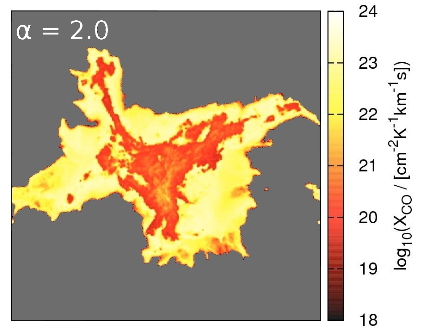 We run numerical simulations of molecular clouds (MCs), adopting properties similar to those found in the Central Molecular Zone (CMZ) of the
Milky Way. For this, we employ the moving mesh code Arepo and perform simulations which account for a simplified treatment of time-dependent
chemistry and the non-isothermal nature of gas and dust. We perform simulations using an initial density of n_0 = 10^3 cm^{-3} and a mass of
1.3x10^5 M_sun. Furthermore, we vary the virial parameter, defined as the ratio of kinetic and potential energy, alpha = E_{kin} / |E_{pot}|,
by adjusting the velocity dispersion. We set it to alpha = 0.5, 2.0 and 8.0, in order to analyze the impact of the kinetic energy on our results.
We account for the extreme conditions in the CMZ and increase both the interstellar radiation field (ISRF) and the cosmic-ray flux (CRF) by a
factor of 1000 compared to the values found in the solar neighbourhood. We use the radiative transfer code RADMC-3D to compute synthetic images
in various diagnostic lines. These are [CII] at 158 micron, [OI] (145 micron), [OI] (63 micron), 12CO (J = 1 -> 0) and 13CO (J = 1 -> 0) at
2600 micron and 2720 micron, respectively. When alpha is large, the turbulence disperses much of the gas in the cloud, reducing its mean density
and allowing the ISRF to penetrate more deeply into the cloud's interior. This significantly alters the chemical composition of the cloud,
leading to the dissociation of a significant amount of the molecular gas. On the other hand, when alpha is small, the cloud remains compact,
allowing more of the molecular gas to survive. We show that in each case the atomic tracers accurately reflect most of the physical properties
of both the H2 and the total gas of the cloud and that they provide a useful alternative to molecular lines when studying the ISM in the CMZ.
We run numerical simulations of molecular clouds (MCs), adopting properties similar to those found in the Central Molecular Zone (CMZ) of the
Milky Way. For this, we employ the moving mesh code Arepo and perform simulations which account for a simplified treatment of time-dependent
chemistry and the non-isothermal nature of gas and dust. We perform simulations using an initial density of n_0 = 10^3 cm^{-3} and a mass of
1.3x10^5 M_sun. Furthermore, we vary the virial parameter, defined as the ratio of kinetic and potential energy, alpha = E_{kin} / |E_{pot}|,
by adjusting the velocity dispersion. We set it to alpha = 0.5, 2.0 and 8.0, in order to analyze the impact of the kinetic energy on our results.
We account for the extreme conditions in the CMZ and increase both the interstellar radiation field (ISRF) and the cosmic-ray flux (CRF) by a
factor of 1000 compared to the values found in the solar neighbourhood. We use the radiative transfer code RADMC-3D to compute synthetic images
in various diagnostic lines. These are [CII] at 158 micron, [OI] (145 micron), [OI] (63 micron), 12CO (J = 1 -> 0) and 13CO (J = 1 -> 0) at
2600 micron and 2720 micron, respectively. When alpha is large, the turbulence disperses much of the gas in the cloud, reducing its mean density
and allowing the ISRF to penetrate more deeply into the cloud's interior. This significantly alters the chemical composition of the cloud,
leading to the dissociation of a significant amount of the molecular gas. On the other hand, when alpha is small, the cloud remains compact,
allowing more of the molecular gas to survive. We show that in each case the atomic tracers accurately reflect most of the physical properties
of both the H2 and the total gas of the cloud and that they provide a useful alternative to molecular lines when studying the ISM in the CMZ.
Figure right:
Logarithmic maps of the CO-to-H2 conversion factor for the alpha = 2.0 model. We see that only the inner parts of the cloud yield the canonical
X_CO-factor value on average, while the outer cloud regions exhibit significantly larger X_CO values. The gray background denotes regions where
the CO emission is zero. Hence, it is impossible to compute a value for X_CO there.
More information:
Bertram, E., Glover, S. C. O., Clark, P. C., Ragan, S. E., Klessen, R. S., MNRAS, 2015
Synthetic observations of molecular clouds in a galactic center environment: I. Studying maps of column density and integrated intensity
Star formation efficiencies of molecular clouds in a galactic center environment
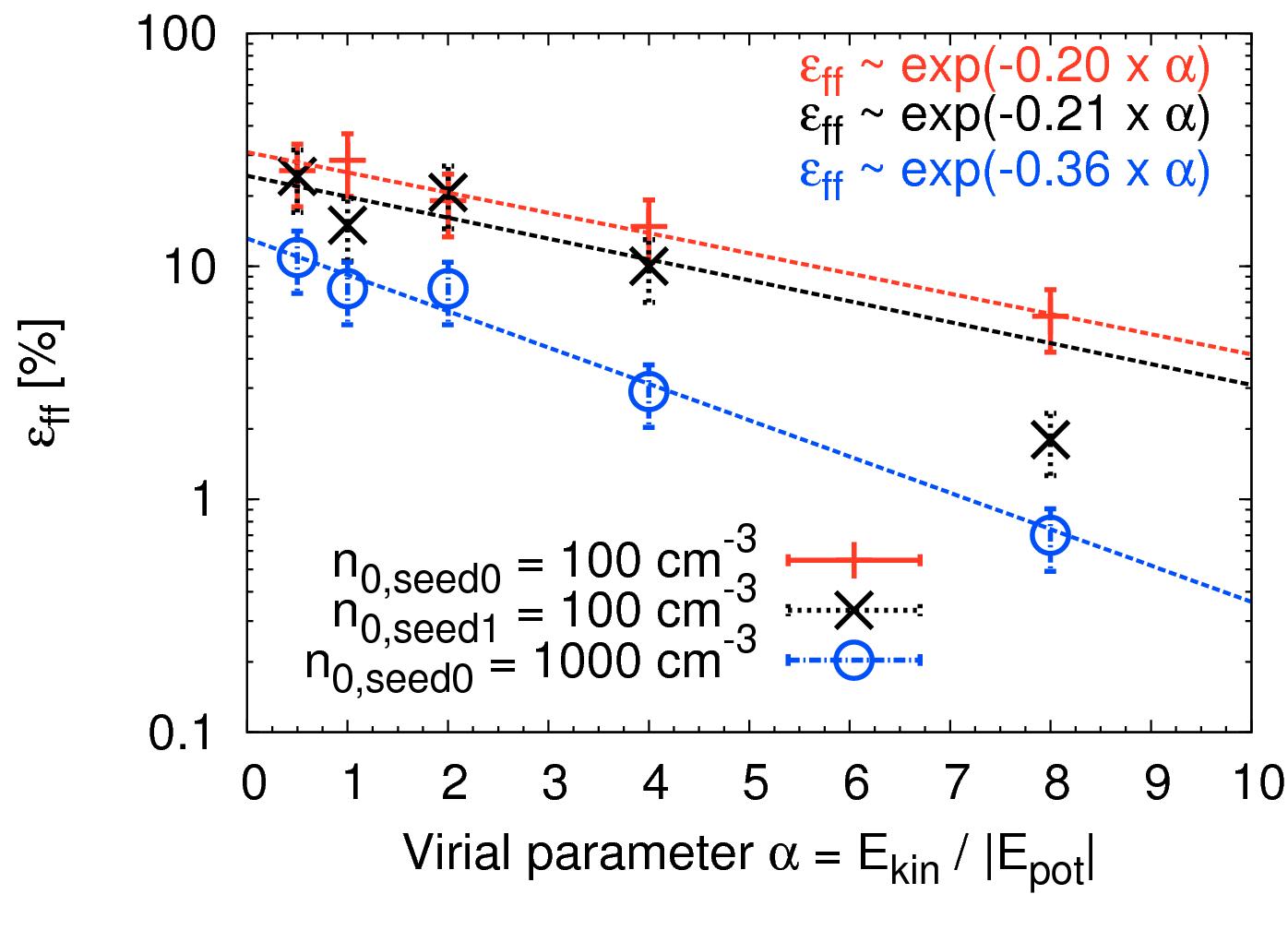 We use the Arepo moving mesh code to simulate the evolution of molecular clouds exposed to a harsh environment similar to that found in the
galactic center (GC), in an effort to understand why the star formation efficiency (SFE) of clouds in this environment is so small. Our
simulations include a simplified treatment of time-dependent chemistry and account for the highly non-isothermal nature of the gas and the dust.
We model clouds with a total mass of 1.3x10^5 M_{sun} and explore the effects of varying the mean cloud density and the virial parameter,
alpha = E_{kin}/|E_{pot}|. We vary the latter from alpha = 0.5 to alpha = 8.0, and so many of the clouds that we simulate are gravitationally
unbound. We expose our model clouds to an interstellar radiation field (ISRF) and cosmic ray flux (CRF) that are both a factor of 1000 higher
than the values found in the solar neighbourhood. As a reference, we also run simulations with local solar neighbourhood values of the ISRF and
the CRF in order to better constrain the effects of the extreme conditions in the GC on the SFE. Despite the harsh environment and the large
turbulent velocity dispersions adopted, we find that all of the simulated clouds form stars within less than a gravitational free-fall time.
Increasing the virial parameter from alpha = 0.5 to alpha = 8.0 decreases the SFE by a factor ~4-10, while increasing the ISRF/CRF by a factor
of 1000 decreases the SFE again by a factor ~2-6. However, even in our most unbound clouds, the SFE remains higher than that inferred for real
GC clouds. We therefore conclude that high levels of turbulence and strong external heating are not enough by themselves to lead to a persistently
low SFE at the center of the Galaxy.
We use the Arepo moving mesh code to simulate the evolution of molecular clouds exposed to a harsh environment similar to that found in the
galactic center (GC), in an effort to understand why the star formation efficiency (SFE) of clouds in this environment is so small. Our
simulations include a simplified treatment of time-dependent chemistry and account for the highly non-isothermal nature of the gas and the dust.
We model clouds with a total mass of 1.3x10^5 M_{sun} and explore the effects of varying the mean cloud density and the virial parameter,
alpha = E_{kin}/|E_{pot}|. We vary the latter from alpha = 0.5 to alpha = 8.0, and so many of the clouds that we simulate are gravitationally
unbound. We expose our model clouds to an interstellar radiation field (ISRF) and cosmic ray flux (CRF) that are both a factor of 1000 higher
than the values found in the solar neighbourhood. As a reference, we also run simulations with local solar neighbourhood values of the ISRF and
the CRF in order to better constrain the effects of the extreme conditions in the GC on the SFE. Despite the harsh environment and the large
turbulent velocity dispersions adopted, we find that all of the simulated clouds form stars within less than a gravitational free-fall time.
Increasing the virial parameter from alpha = 0.5 to alpha = 8.0 decreases the SFE by a factor ~4-10, while increasing the ISRF/CRF by a factor
of 1000 decreases the SFE again by a factor ~2-6. However, even in our most unbound clouds, the SFE remains higher than that inferred for real
GC clouds. We therefore conclude that high levels of turbulence and strong external heating are not enough by themselves to lead to a persistently
low SFE at the center of the Galaxy.
Figure left:
Star formation efficiencies per free-fall time against the corresponding virial parameter for our fiducial density models. We generally find
a decreasing trend of the SFEs with higher value of the virial parameter for all density models. Although there are slight differences in the
individual SFEs between the two seed models, we nevertheless find the same general trends of decreasing SFE with increasing α.
To illustrate the different trends, we also fit exponential functions to the models and list the corresponding slopes in the plot. Error bars
indicate variations of the SFE of ∼ 30%.
More information:
Bertram, E., Glover, S. C. O., Clark, P. C., Klessen, R. S., MNRAS, 2015
Star formation efficiencies of molecular clouds in a galactic center environment
Structure analysis of simulated molecular clouds with the Delta-variance
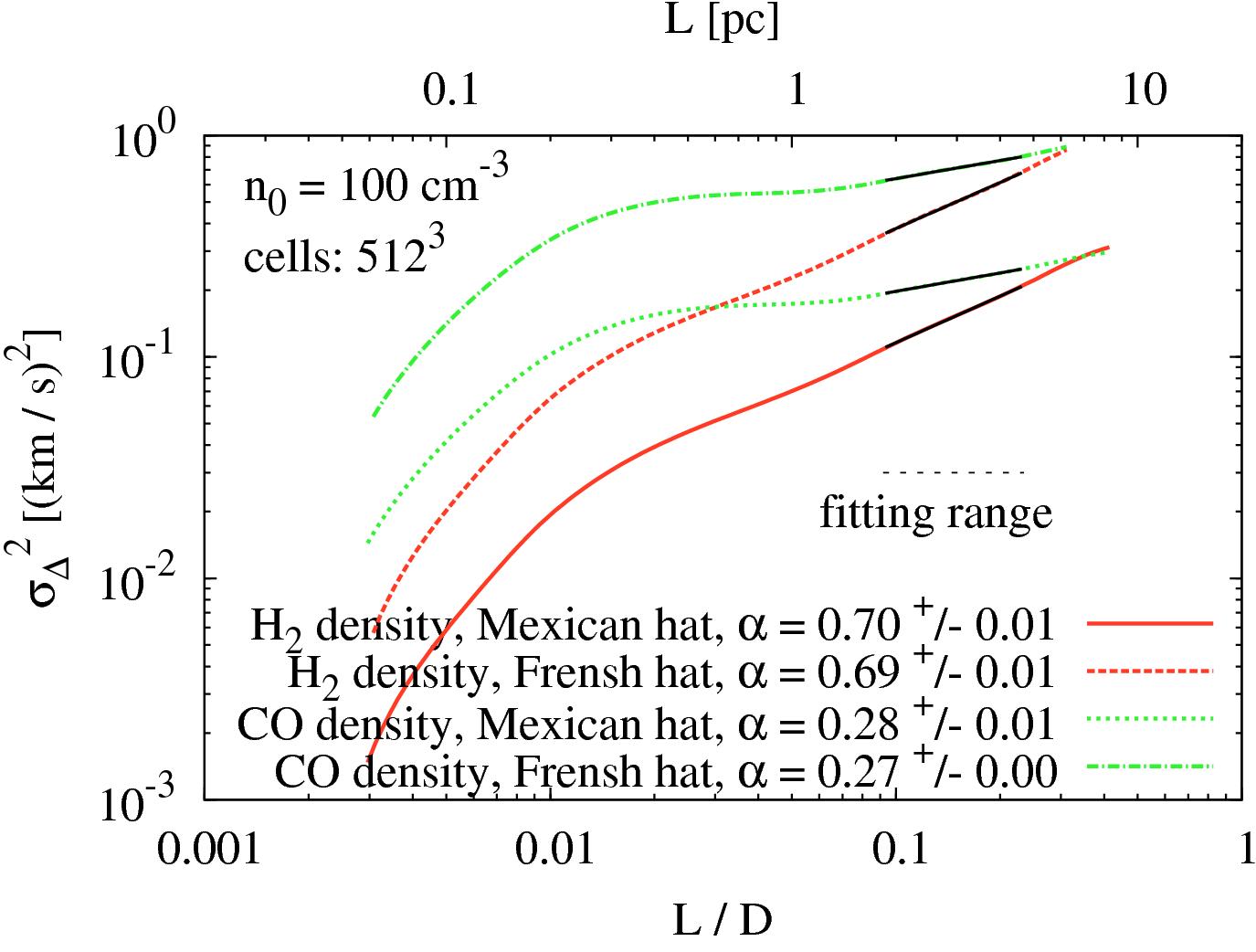 We employ the Delta-variance analysis and study the turbulent gas dynamics of simulated molecular clouds (MCs). Our models account for a
simplified treatment of time-dependent chemistry and the non-isothermal nature of the gas. We investigate simulations using three different
initial mean number densities of n_0 = 30, 100 and 300 cm^{-3} that span the range of values typical for MCs in the solar neighbourhood.
Furthermore, we model the CO line emission in a post-processing step using a radiative transfer code. We evaluate Delta-variance spectra for
centroid velocity (CV) maps as well as for integrated intensity and column density maps for various chemical components: the total, H2 and 12CO
number density and the integrated intensity of both the 12CO and 13CO (J = 1 -> 0) lines. The spectral slopes of the Delta-variance computed on
the CV maps for the total and H2 number density are significantly steeper compared to the different CO tracers. We find slopes for the
linewidth-size relation ranging from 0.4 to 0.7 for the total and H2 density models, while the slopes for the various CO tracers range from 0.2
to 0.4 and underestimate the values for the total and H2 density by a factor of 1.5-3.0. We demonstrate that optical depth effects can
significantly alter the Delta-variance spectra. Furthermore, we report a critical density threshold of ~100 cm^{-3} at which the Delta-variance
slopes of the various CO tracers change sign. We thus conclude that carbon monoxide traces the total cloud structure well only if the average
cloud density lies above this limit.
We employ the Delta-variance analysis and study the turbulent gas dynamics of simulated molecular clouds (MCs). Our models account for a
simplified treatment of time-dependent chemistry and the non-isothermal nature of the gas. We investigate simulations using three different
initial mean number densities of n_0 = 30, 100 and 300 cm^{-3} that span the range of values typical for MCs in the solar neighbourhood.
Furthermore, we model the CO line emission in a post-processing step using a radiative transfer code. We evaluate Delta-variance spectra for
centroid velocity (CV) maps as well as for integrated intensity and column density maps for various chemical components: the total, H2 and 12CO
number density and the integrated intensity of both the 12CO and 13CO (J = 1 -> 0) lines. The spectral slopes of the Delta-variance computed on
the CV maps for the total and H2 number density are significantly steeper compared to the different CO tracers. We find slopes for the
linewidth-size relation ranging from 0.4 to 0.7 for the total and H2 density models, while the slopes for the various CO tracers range from 0.2
to 0.4 and underestimate the values for the total and H2 density by a factor of 1.5-3.0. We demonstrate that optical depth effects can
significantly alter the Delta-variance spectra. Furthermore, we report a critical density threshold of ~100 cm^{-3} at which the Delta-variance
slopes of the various CO tracers change sign. We thus conclude that carbon monoxide traces the total cloud structure well only if the average
cloud density lies above this limit.
Figure right:
Delta-variance spectra for the turbulent velocity field of our H2 and CO density models for a fixed initial number density of n_0 = 100 cm^{-3}
and a resolution of 512^3 grid cells, computed for the centroid velocity (CV) maps. In order to analyze the impact of the filter function and
its diameter ratio on our results, we compute the H2 and CO density spectra using both a Mexican hat with a diameter ratio of 1.5 and a French hat with a
diameter ratio of 3.0. We do not find any significant differences in the slopes within the fitting errors if we use a another filter
function for the Delta-variance analysis combined with a different diameter ratio.
More information:
Bertram, E., Klessen, R. S., Glover, S. C. O., MNRAS, 2015
Structure analysis of simulated molecular clouds with the Delta-variance
Centroid Velocity Statistics of Molecular Clouds
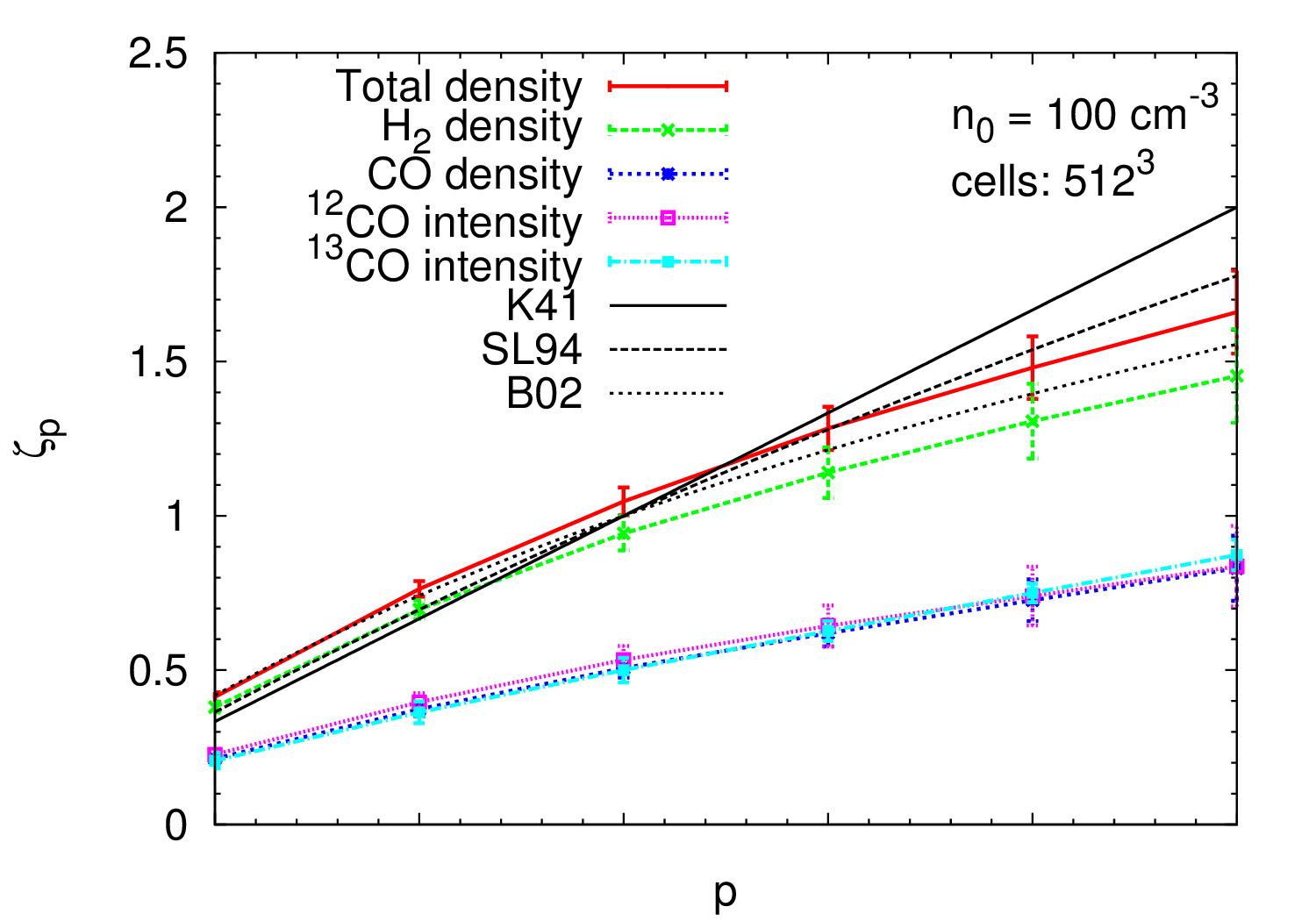 We compute structure functions and Fourier spectra of 2D centroid velocity (CV) maps in order to study the gas dynamics of typical molecular clouds
(MCs) in numerical simulations. We account for a simplified treatment of time-dependent chemistry and the non-isothermal nature of the gas and use a
3D radiative transfer tool to model the CO line emission in a post-processing step. We perform simulations using three different initial mean number
densities of n_0 = 30, 100 and 300 cm^{-3} to span a range of typical values for dense gas clouds in the solar neighbourhood. We compute slopes of
the centroid velocity increment structure functions (CVISF) and of Fourier spectra for different chemical components: the total density, H2 number
density, 12CO number density as well as the integrated intensity of 12CO (J=1-0) and 13CO (J=1-0). We show that optical depth effects can
significantly affect the slopes derived for the CVISF, which also leads to different scaling properties for the Fourier spectra. The slopes of CVISF
and Fourier spectra for H2 are significantly steeper than those for the different CO tracers, independent of the density and the numerical
resolution. This is due to the larger space-filling factor of H2 as it is better able to self-shield in diffuse regions, leading to a larger fractal
co-dimension compared to CO.
We compute structure functions and Fourier spectra of 2D centroid velocity (CV) maps in order to study the gas dynamics of typical molecular clouds
(MCs) in numerical simulations. We account for a simplified treatment of time-dependent chemistry and the non-isothermal nature of the gas and use a
3D radiative transfer tool to model the CO line emission in a post-processing step. We perform simulations using three different initial mean number
densities of n_0 = 30, 100 and 300 cm^{-3} to span a range of typical values for dense gas clouds in the solar neighbourhood. We compute slopes of
the centroid velocity increment structure functions (CVISF) and of Fourier spectra for different chemical components: the total density, H2 number
density, 12CO number density as well as the integrated intensity of 12CO (J=1-0) and 13CO (J=1-0). We show that optical depth effects can
significantly affect the slopes derived for the CVISF, which also leads to different scaling properties for the Fourier spectra. The slopes of CVISF
and Fourier spectra for H2 are significantly steeper than those for the different CO tracers, independent of the density and the numerical
resolution. This is due to the larger space-filling factor of H2 as it is better able to self-shield in diffuse regions, leading to a larger fractal
co-dimension compared to CO.
Figure left: Slopes of the structure functions against order p for all chemical models for a number density of n_0 = 100 cm^{-3}, i.e. the
total density, H2 density and the CO density model as well as the 12CO and 13CO intensity model. For comparison, we also show the theoretical scaling relations (black
lines) from Kolmogorov, She-Leveque and Boldyrev, denoted as K41, SL94 and B02. Error bars denote temporal and spatial 1-sigma fluctuations.
Please note that a direct comparison of the theoretical models with our CV statistics is complicated due to the projection along the LoS.
More information:
Bertram, E., Konstandin, L., Shetty, R., Glover, S. C. O., Klessen, R. S., MNRAS, 2014
Centroid Velocity Statistics of Molecular Clouds
Principal Component Analysis of Molecular Clouds: Can CO reveal the dynamics?
We use Principal Component Analysis (PCA) to study the gas dynamics in numerical simulations of typical MCs. Our simulations account for the non-isothermal nature of the gas and include a
simplified treatment of the time-dependent gas chemistry. We model the CO line emission in a post-processing step using a 3D radiative transfer code. We consider mean number densities n_0 = 30, 100,
300 cm^{-3} that span the range of values typical for MCs in the solar neighbourhood and investigate the slope \alpha_{PCA} of the pseudo structure function computed by PCA for several components:
the total density, H2 density, 12CO density, 12CO J = 1 -> 0 intensity and 13CO J = 1 -> 0 intensity. We estimate power-law indices \alpha_{PCA} for different chemical species that range from 0.5 to 0.9, in
good agreement with observations, and demonstrate that optical depth effects can influence the PCA. We show that when the PCA succeeds, the combination of chemical inhomogeneity and radiative
transfer effects can influence the observed PCA slopes by as much as ~ +/- 0.1. The method can fail if the CO distribution is very intermittent, e.g. in low-density clouds where CO is confined to
small fragments.
Figure right: Integrated intensity maps for 12CO on a linear scale computed along the LoS in z-direction for different times and turbulent velocity fields for models n100 (top)
and n300 (bottom), corresponding to runs with inital number densities of 100 and 300 cm^{-3}. In model n100 there is less CO emission produced at low densities than in the n300 model. Note the
different scaling in the colorbars.
More information:
Bertram, E., Shetty, R., Glover, S. C. O., Klessen, R. S., Roman-Duval, J., Federrath, C., MNRAS, 2014
Principal Component Analysis of Molecular Clouds: Can CO reveal the dynamics?
Statistical analysis of the mass-to-flux ratio in turbulent cores: effects of magnetic field reversals and dynamo amplification
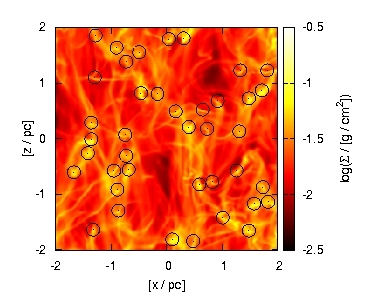 We study the mass-to-flux ratio (M/\Phi) of clumps and cores in simulations of supersonic, magnetohydrodynamical turbulence for different initial magnetic field strengths. We investigate whether the
(M/\Phi)-ratio of core and envelope, R = (M/\Phi)_{core}/(M/\Phi)_{envelope} can be used to distinguish between theories of ambipolar diffusion and turbulence-regulated star formation. We analyse R
for different Lines-of-Sight (LoS) in various sub-cubes of our simulation box. We find that, 1) the average and median values of |R| for different times and initial magnetic field strengths are
typically greater, but close to unity, 2) the average and median values of |R| saturate at average values of |R| ~ 1 for smaller magnetic fields, 3) values of |R| < 1 for small magnetic fields in the
envelope are caused by field reversals when turbulence twists the field lines such that field components in different directions average out. Finally, we propose two mechanisms for generating values
|R| ~< 1 for the weak and strong magnetic field limit in the context of a turbulent model. First, in the weak field limit, the small-scale turbulent dynamo leads to a significantly increased flux in
the core and we find |R| ~< 1. Second, in the strong field limit, field reversals in the envelope also lead to values |R| ~< 1. These reversals are less likely to occur in the core region where the
velocity field is more coherent and the internal velocity dispersion is typically subsonic.
We study the mass-to-flux ratio (M/\Phi) of clumps and cores in simulations of supersonic, magnetohydrodynamical turbulence for different initial magnetic field strengths. We investigate whether the
(M/\Phi)-ratio of core and envelope, R = (M/\Phi)_{core}/(M/\Phi)_{envelope} can be used to distinguish between theories of ambipolar diffusion and turbulence-regulated star formation. We analyse R
for different Lines-of-Sight (LoS) in various sub-cubes of our simulation box. We find that, 1) the average and median values of |R| for different times and initial magnetic field strengths are
typically greater, but close to unity, 2) the average and median values of |R| saturate at average values of |R| ~ 1 for smaller magnetic fields, 3) values of |R| < 1 for small magnetic fields in the
envelope are caused by field reversals when turbulence twists the field lines such that field components in different directions average out. Finally, we propose two mechanisms for generating values
|R| ~< 1 for the weak and strong magnetic field limit in the context of a turbulent model. First, in the weak field limit, the small-scale turbulent dynamo leads to a significantly increased flux in
the core and we find |R| ~< 1. Second, in the strong field limit, field reversals in the envelope also lead to values |R| ~< 1. These reversals are less likely to occur in the core region where the
velocity field is more coherent and the internal velocity dispersion is typically subsonic.
Figure left:
Logarithmic column density map computed along the LoS in y-direction for an initial plasma beta of 0.01 (i.e. for a very strong field, left). One can see the outstanding z-direction of the magnetic
field lines. Also labelled are the positions of 40 density-peaks (dot in the middle of each circle), which fulfil a threshold condition and the maximum diameter of the envelopes (circles).
More information:
Bertram, E., Federrath, C., Banerjee, R., Klessen, R. S., MNRAS, 2011
Statistical analysis of the mass-to-flux ratio in turbulent cores: effects of magnetic field reversals and dynamo amplification
